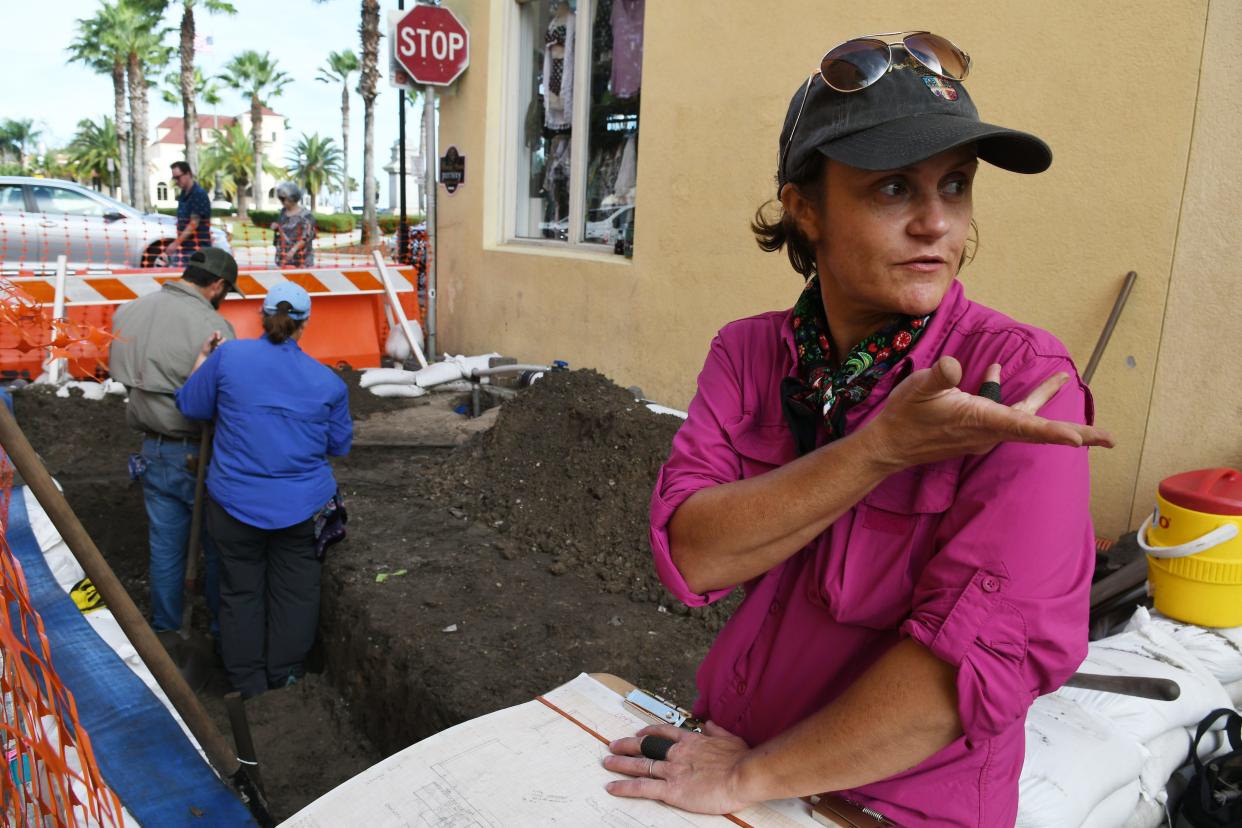St. Augustine city official on sea-level rise: 'I feel like time is not on our side'

Andrea White, St. Augustine's city government archaeologist, knows that waters are rising.
White was the assistant city archaeologist about 20 years ago before leaving the city. She became the city archaeologist about five years ago.
"I know the water table is rising from the empirical evidence like working here 20 years ago versus working here now," White said. "The water table is higher. … Some of the burials on Charlotte Street were in the water table ― a lot of features, building foundations, things like that. We have to stop excavating because we're hitting the water table. And the water table fluctuates. And the worst thing for archaeological sites is when they become wet and then dry, wet and dry. That starts the deterioration and erosion process faster."
Confederate general's burial: Loring's remains, sword pieces found at monument site in St. Augustine
Growth and development: 'The Quadrant' would bring 300 hotel rooms and more to St. Johns County
Restaurant report: 13 St. Johns County restaurants get high-priority violations, two ace inspections
Spanish settlers founded St. Augustine in 1565, but Native Americans inhabited the land for over 4,000 years prior, according to the 2020 "Resilient Heritage in the Nation's Oldest City" report. Over those many years, people have left remnants of their ways of life.
The Resilient Heritage report was created for the city government to help officials face challenges from storms, sea-level rise and nuisance flooding.
One city project, supported by a $217,000 state Resilient Florida grant, will monitor groundwater networks for sea-level rise.
"This effort will focus on predicting impacts, specifically to critical infrastructure, of sea-level rise by installing a monitoring network to accurately measure rates of change in current shallow groundwater elevation and water quality," according to a city document.
At least 60 monitoring points will be placed in the city and will be monitored by a professional, licensed surveyor.
"All data (sea level, groundwater, water quality and creek level) will be compiled and summarized quarterly, building the data set," according to the city. "Daily rainfall along with any severe storm activity will also be summarized."
Preservation below and above ground
Named St. Augustine by Spanish settlers in the 16th century, the city is home to the remains of colonial structures, burial grounds, former plantation sites, former missions and one of its most famous historical resources: the Castillo de San Marcos, a centuries-old fort that's still standing and open for tours.
White said much of her archaeological investigations are driven by development that trigger the city's archaeological preservation ordinance.
Created in 1986, the ordinance doesn't stop or limit development but seeks "to collect information from archaeological sites through documentation when cultural deposits are threatened by destruction," according to the Resilient Heritage report.
Things that are buried in the ground are harder to inventory, White said. Though some have been found and catalogued, the city doesn't know how many sites and artifacts are underground, she said.
Digging is destructive, and the city can't stop all of the impacts of sea-level rise. So the city studied alternatives as part of the Resilient Heritage report.
One strategy is to prioritize preservation of the existing artifacts the city possesses, which are considered an extension of archaeological sites in the ground, White said. They include things like pieces of potter, shells and bones. As time and technology progress, they can be sources of new information. So the city takes care to preserve them.
"We have one of the best Spanish colonial collections … arguably in the country if not the entire Western Hemisphere," she said.
The city is also using mapping technology to plot the locations of its archaeological projects, which isn't for public viewing to keep the artifacts safe, White said.
Facing the dangers
If waters keep rising as expected, the city could face tough decisions about how, and what, to defend among its historic resources.
The Resilient Heritage report, which the Florida Department of State's Division of Historical Resources helped fund, provides a framework for managing historic those resources.
The report includes flood-mitigation concepts for The Llambias House, a National Historic Landmark; the Plaza de la Constitucion, the nation's first public space; and City Hall, a building that used to serve as one of Henry Flagler's hotels.
The report proposed elevating areas just east of the Plaza, creating underground cisterns and using a temporary flood barrier on the east end of the Plaza when major floodwaters are expected.
"One advantage of raising the street surface and crosswalk islands is the potential for creating an underground stormwater retention system," according to the report. "Rough estimates of the project area with a depth between 3 and 5 feet indicate that approximately 1 million gallons of floodwater could be intercepted with the addition of underground rainwater and stormwater storage. … While this elevation seems excessive, the surrounding roadways would be graded accordingly to reduce a large jump in elevation difference."
The Resilient Heritage area study says that "some archaeological zones" are already feeling the effects of nuisance flooding and are vulnerable to increased impacts from sea-level rise.
"We already know nuisance flooding effects, you know, 60% of our (archaeology) zones," White said, adding that there are many different sea level rise projections that change frequently.
"I feel like time is not on our side," she said.
This article originally appeared on St. Augustine Record: St. Augustine officials fight sea-level rise, storms, nuisance flooding

